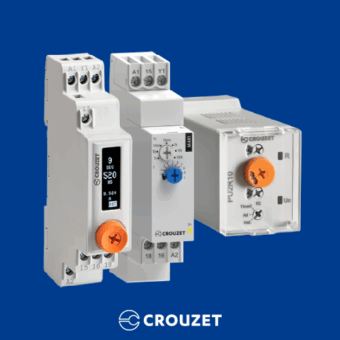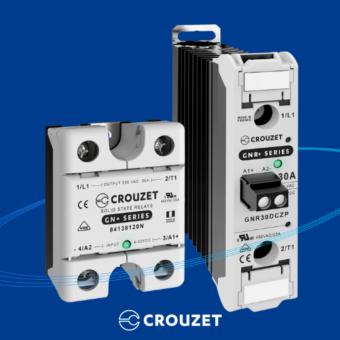Microswitches, often underappreciated yet essential, play a crucial role in numerous industrial and domestic applications. Thanks to their compact design and high reliability, these snap-action switches (some models also offer slow-action functionality) provide tailored solutions for demanding and diverse environments. Whether it’s for controlling equipment, ensuring safety, or delivering precise performance, microswitches are indispensable in fields such as automation, household appliances, automotive, and many more.
In this article, we introduce the main types of microswitches, their distinctive features, and the applications in which they excel. Discover how these discreet components can ensure the reliability and efficiency of your systems.
What is a microswitch?
A microswitch is an electromechanical device with snap-action or slow-action functionality, designed to open or close an electrical circuit in response to a change in position and/or force applied to its mechanism. Known for its precision and reliability, the microswitch stands out for its snap-action mechanism, enabling instantaneous switching regardless of the actuation speed.
Its compact and robust design makes it ideal for a wide range of applications, from safety systems and household appliances to industrial equipment and vehicles. Microswitches offer long service life, high operational precision, and remarkable adaptability, thanks to their diverse contact configurations, actuation forces, and sizes.
Microswitches also minimize power loss in electrical circuits due to their low contact resistance.
The different switching types for a microswitch
Microswitches offer a variety of switching types to meet specific needs for control and safety in electrical circuits. Here are the main switching types:
Single-Pole Single-Throw (SPST) Switching
In this configuration, the circuit is open by default, and no current flows. When the microswitch is activated, the contact closes, allowing current to pass through.
Applications: Ideal for activating devices or systems only when a specific action occurs (e.g., push buttons).

Double-Pole Double-Throw (DPDT) Switching
In this configuration, the circuit is closed by default, and current flows continuously. When the microswitch is activated, the contact opens, interrupting the flow of current.
Applications: Used in systems requiring automatic shutdown upon activation (e.g., safety switches).

Double-Break with Separate Circuits
This is a more complex microswitch with electrical separation between the two circuits, capable of controlling two distinct circuits, each with a NO (normally open) and NC (normally closed) contact.
Applications: Suitable for systems requiring simultaneous control of multiple circuits or redundant configurations for enhanced safety.

How does a microswitch work?
A microswitch operates through a mechanism that enables the activation or deactivation of an electrical circuit in response to force applied to its actuator. This functionality relies on precise and robust mechanical components, ensuring quick, reliable switching, independent of the speed or intensity of the actuation.
In the case of a single-break configuration, the current flows through the common terminal, which connects to a tensioned spring linked to a movable component (electrically conductive). At rest, the spring touches the NC terminal and is connected to the actuator. Once the actuator is engaged, the movable component shifts position, and the NO terminal is then powered.
- COM for “common,”
- NO for “normally open,”
- NF or NC for “normally closed.”
The Steps of Microswitch Operation
- Rest Position: In its default state, the internal electrical contact is either closed (NC – normally closed) or open (NO – normally open), depending on the microswitch configuration. No current flows in the case of a normally open contact.
- Actuation: When the actuator (a lever, push-button, or another mechanism) is subjected to sufficient external force to exceed the operating force (OF), the internal mechanism triggers abruptly. This rapid movement is due to the design of the snap-action system, which transitions instantaneously from one stable position to another.
- Switching: The snap-action mechanism alters the state of the internal electrical contacts:
- If the microswitch is normally open (NO), the contact closes, and current flows.
- If the microswitch is normally closed (NC), the contact opens, interrupting the current.
- For toggle microswitches (SPDT or DPDT), the current switches from one circuit to another.
- Return to Initial Position: Once the applied force is removed or reduced below a certain threshold (known as the release force, RF), the internal mechanism returns to its initial position, restoring the circuit’s default state.
What are the advantages of the microswitch?
Microswitches, also known as micro-switches, are widely used across various industries due to their numerous advantages. Their ingenious design and reliable performance make them essential components in applications where precision, safety, and durability are critical. Here are the key benefits of microswitches:
- Snap-action mechanism ensures instantaneous switching, independent of actuation speed. This allows precise control, even in demanding or high-frequency environments.
- High durability: Microswitches are designed to withstand millions of mechanical and electrical cycles without losing precision, making them an economical and long-lasting choice.
- Compact size: Their small size enables integration into tight spaces while maintaining high electrical capacity. They are available in a wide range of sizes, actuation forces, and switching types (NO, NC, SPDT, etc.).
- Versatile load handling: They can handle low or high loads, ranging from electronic signals (a few milliamps) to high-intensity industrial applications (several amps).
- Easy installation: Equipped with various connection options (terminals, wires, connectors) and mounting systems tailored to user needs, they are easy to install and integrate into different systems.
- Robust construction: Available with sealed housings and durable materials, they can withstand harsh conditions (extreme temperatures, humidity, dust, vibrations, and shocks).
- Minimal electrical loss: Microswitches generate virtually no electrical loss.
What are the uses of a microswitch?
Microswitches, with their quick-action mechanism, precision, and durability, are used in a wide range of industrial, commercial, and domestic sectors. Here are some examples of microswitch applications:
- Industrial Applications:
- Automation: Position detection in robotic arms or machine tools, monitoring conveyor systems, and production lines.
- Equipment Control: Activating or deactivating circuits in machinery or monitoring fluid levels.
- Automotive Sector:
- Safety: Detecting seatbelt positions or activating/deactivating airbags.
- Mechanical Systems: Controlling door locking systems or monitoring fluid levels.
- Medical Field:
- Medical Devices: Position detection in diagnostic equipment or controlling infusion pumps to ensure proper operation.
- Telecommunications:
- Printed Circuit Boards (PCBs): Activating specific functions in electronic systems or using miniature switches for precision controls.
- Aerospace and Railway
- Control Systems: Detecting positions of aircraft flaps and hatches or monitoring braking systems.
- Equipment Integration: Used in signaling systems and position detection devices.
Microswitches are indispensable components in numerous industries. Their versatility, reliability, and longevity make them an ideal solution for any system requiring precise detection, reliable control, or enhanced safety. Whether for simple applications or complex systems, they meet a wide variety of demands.
All Crouzet Microswitches offer
Discover more
All news
What is a timer relay?
In the field of industrial automation, precision and reliability are essential criteria for ensuring the proper…

Plan your visit to the 2025 Paris Air Show (and meet us there)
The Paris Air Show, the unmissable event of the global aerospace industry, will open its doors…

Solid state relay or electro mechanical relay?
In the modern world of automation and energy management, the choice between a solid-state relay (SSR)…

What is a solid state relay (SSR) ?
In the field of industrial automation and energy management, relays play a crucial role in ensuring…